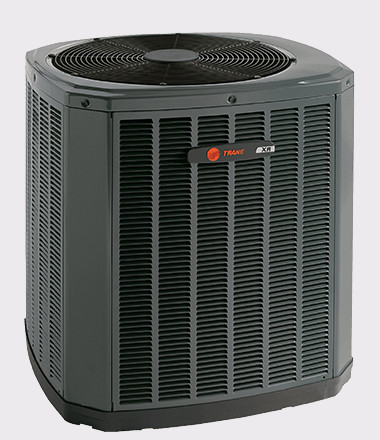


Author:
Revised:
January 23rd, 2024
Are you in the market for a new heat pump? Is your unit old, and you’re not sure it can handle the rigors of a new season? Are you tired of seeing HVAC maintenance people work on it, and have decided a better investment might be a new one?
At Fire & Ice, we have helped thousands of Columbus homeowners find the HVAC system that best meets their individual needs. When considering heat pumps, we’re often asked if there’s a model that will lower your energy bills, help make you more comfortable, and be more affordable than other high-end heat pumps. The Trane XR17 fits the bill and might be perfect for you.
In this article, we’ll go over its features, examine the cost, and see who will get the most benefit from this system.
We’ll cover the most common questions about this heat pump, such as:
What are the features of the Trane XR17?
How does the XR17’s two-stage compressor provide greater comfort?
What is the efficiency rating for the XR17?
Who’s the right fit for the Trane XR17 heat pump?
How much does the XR17 cost?By the end of this article, you’ll know if the Trane XR17 is right for you.
Features of the Trane XR17 Heat Pump
- Two-Stage Climatuff™ compressor
- Galvanized-steel louvered panels
- Baked-on powder paint
- Corrosion-resistant Weatherguard™ fasteners
- Spine Fin™ outdoor coil
- DuraTuff™ rust-proof base pan
- Sound insulator on compressors (on select models)
- Energy Star Qualified
{Trane's Patented Spine Fin Technology https://www.youtube.com/watch?v=eSWtNu3DS1k}
The heating and cooling reliability you expect from Trane and the energy efficiency you deserve can be found in our XR17 two-stage electric heat pump. The XR17’s ratings up to 17.25 SEER and up to 9.6 HSPF make it an energy-efficient choice for home comfort.
Two stages of cooling and heating meet any outdoor climate conditions and prevent interior temperature swings. If you’re tired of cold spots in the winter or hot spots in the summer, the Trane XR17 can help even out the temperatures in your home.
Match your heat pump with a gas furnace to enjoy the energy-saving benefits of a hybrid system, a.k.a. dual fuel. Your heat pump will be in charge of providing much of the heat for your home, then your furnace takes over when the weather gets too cold.
How Does a Two-Stage Compressor Provide Greater Comfort?
A two-stage heat pump has a compressor that can operate at two distinct speeds. A one-stage compressor is either on 100% or entirely off. The two-stage compressor has this same 100% setting, but it also has another stage that, while it varies depending on brand and model, is generally around 60% - 70% capacity.
You’re probably familiar with the traditional one-stage model and equally familiar with how it will shut on and off depending on the temperature.
Say you set your thermostat to 72 degrees. The heat pump might let the home get to 73 before kicking on, then cool it to 72 or 71. Then the cycle repeats.
With a two-stage compressor, the system will work less hard when the inside temperature is close to the thermostat’s setting, thus using less energy and preventing the need to turn on to 100% so often. Also, the less your unit turns on and shuts off, the longer its lifespan.
Two-stage heat pumps are going to provide more efficiency compared to single-stage heat pumps. They’re a nice middle ground between low-end and high-end efficiency, and the initial cost will save you on energy costs compared to a single-stage.
A single-stage heat pump will start to struggle to produce heat when the temperature drops to 40 degrees Fahrenheit or lower. A two-stage will work at 100% efficiency down to 40 degrees, and will drop down to its slower speed - 60% -70% - when the temperature is lower. That provides more heat than a single-stage, and the performance drop-off isn’t as steep as that of a single-stage.
https://vimeo.com/452250262 What’s Single-Stage, Two-Stage and Variable Speed Cooling?
How Is Heat Pump Efficiency Rated?
SEER
SEER stands for Seasonal Energy Efficiency Ratio. It’s calculated by the ratio of cooling produced by a heat pump, divided by its energy usage in watt-hours. This ratio is calculated over the length of a typical cooling season.
SEER ratings in modern heat pumps range from about 13 to 22. Depending on the state you live in, any new air conditioner that’s installed must be at least SEER 14 (in some states it’s higher).
SEER is often used as shorthand for the efficiency of a system. However, SEER isn’t the final word in an air conditioner’s efficiency. The rating has some limitations that homeowners should be aware of.
- SEER ratings should always be read as “up to” that amount. For example, a 20 SEER system is capable of being up to 20 SEER efficiency. It will not always be at that level, due to variations in your HVAC system.
- A high-SEER system that is poorly installed will often be no more efficient than a lower-SEER system that is properly installed.
- Many older systems are no higher than about 8 SEER. The savings and comfort difference between those and a 13 SEER system is significant. How large the difference is will depend on your previous air conditioner or heat pump, but the comfort increase and cost savings can be eye-opening.
- SEER is only as good as the equipment that it’s paired with. Efficiency is determined by the entire HVAC system, including ventilation, ductwork, and your air handler or furnace. Your outdoor condensing unit and your indoor coil work together as a team—a new heat pump’s efficiency will be significantly reduced if it’s paired with an old, existing coil or a non-Trane coil. An older coil, or a non-Trane coil, may even differ in cooling capacity and performance, leaving you with an unbalanced system and higher-than-necessary utility bills.

HSPF
HSPF stands for Heating Seasonal Performance Factor. This rating is limited to heat pumps. It’s used to calculate their efficiency when they’re heating a home. (When heat pumps cool a home, efficiency is measured in SEER, just like air conditioners.)
As with SEER, the higher the rating, the more efficient the unit. The numbers used are different, though. Similar to SEER, the rating is calculated by dividing the heating output (measured in British Thermal Units or BTUs) by the energy consumed.
Modern heat pumps must have an HSPF of 7.7, which is again an average. As temperatures drop in the winter, the HSFP of a heat pump will decline. The most sophisticated heat pumps can reach 10+ HSPF.
The Trane XR17 Compared to the Trane XL18i
The Trane XL18i is very similar to the XR17. Unlike the Trane XL18i, the Trane XL17 doesn’t come with a Weatherguard Top. If you have a lot of trees, and you’re getting a lot of leaves and debris falling on your heat pump, then it makes sense to do an XL18i. The SEER rating of the XL18i is also slightly higher, but otherwise, it’s almost the exact same heat pump.
The two-stage compressor will give the exact same feel in comfort, but the XL18i is more expensive. If you’re looking at two-stage systems, unless you have a ton of trees in the area, there’s little reason to go up to the XL18i.
This is due in part to the high testing Trane does. All these units are tested the same way. Even without that Weatherguard Top, the XR17 is designed to hold up in tough conditions. It’s designed to be outside. It can get wet. It can have rain and snow and ice on it and still perform to expectations.
Comparing the Trane XR17 Heat Pump
See how the Trane XR17 Heat Pump stacks up to other comparable units.
Who’s the Right Fit for the Trane XR17 Heat Pump?
The Trane XR17 is a good fit for homeowners who plan to stay in their home long-term and are looking for a heat pump that will increase their comfort, be efficient, and is less expensive than higher-end models.
Thanks to its two-stage compressor, the XR17 can provide even heating and cooling. If energy savings are a concern, it’s been shown that people who have switched to an XR17 from an older 10 SEER or lower heat pump can save an estimated 50% in their annual energy costs.

If you plan on moving out of your home in the next five years, and your current single-stage heat pump already meets your heating and cooling needs, the XR17 might be more system than you need.
What Is the Cost of a Trane XR17 Heat Pump?
The price range for a Trane XR17 is anywhere from $7,590 - $10,670. At Fire & Ice, our estimates include the cost of equipment, labor, and any additional fees. If your system is all-electric, you will need to replace the air handler as well, which typically adds around $3,850 to $6,600. The factors that can affect the price of your heat pump replacement include:
- Capacity/power of the system
- Efficiency
- The HVAC equipment that you’re not replacing
- Modifications to your existing system
- Line set protection
- Installation costs
- Tax credits and rebates
For comparison, a new heat pump installation can range between $6,050 and $14,300.
Take the Next Steps
Many factors can affect the price of a heat pump, such as the size of your home, filters, and other indoor air quality products, and any modifications that are needed during installation. There are no one-size-fits-all solutions when it comes to HVAC systems.
Here are some more articles that you might find useful on your journey toward comfort:
How Much Does a Heat Pump Cost to Replace in 2021?
Cost of an Air Conditioner Replacement in 2021, A Complete Breakdown
Trane Gas Furnace Guide: 2021 Pricing & Product Reviews
Let’s talk about what to do next. If you think the Trane XR17 is right for you, or you want to discuss a different HVAC problem, enter your zip code in the graphic below to get a free estimate for installation.




























